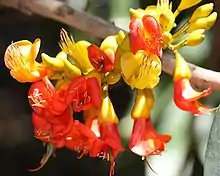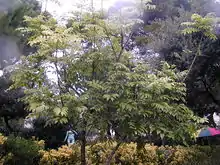| Moreton Bay chestnut | |
|---|---|
 | |
| Street tree in Pretoria | |
| Scientific classification | |
| Kingdom: | Plantae |
| Clade: | Tracheophytes |
| Clade: | Angiosperms |
| Clade: | Eudicots |
| Clade: | Rosids |
| Order: | Fabales |
| Family: | Fabaceae |
| Subfamily: | Faboideae |
| Tribe: | Angylocalyceae |
| Genus: | Castanospermum A.Cunn ex Mudie (1829)[2][3] |
| Species: | C. australe |
| Binomial name | |
| Castanospermum australe | |
| Synonyms[5][3] | |
|
Genus: Species:
| |
Castanospermum is a monotypic genus in the legume family Fabaceae. The sole species is Castanospermum australe, commonly known as Moreton Bay chestnut or black bean,[1][6][7] which is native to rainforested areas on the east coast of Queensland and northeastern New South Wales, and to the southwest Pacific islands of Vanuatu and New Caledonia[5][8]
Description
The black bean is a large evergreen tree growing up to 40 m (130 ft) tall,[7][9] though commonly much smaller. The leaves are 15 centimetres (5.9 in) long and 6–7 centimetres (2.4–2.8 in) broad, pinnate, with 11-15 leaflets. The flowers are bicoloured red and yellow, 3–4 centimetres (1.2–1.6 in) long, produced in racemes 6 centimetres (2.4 in) long. The fruit is a cylindrical pod 12–20 centimetres (4.7–7.9 in) long and 4–6 centimetres (1.6–2.4 in) diameter, the interior divided by a spongy substance into one to five cells, each of which contains a large chestnut-like seed.
Common names
The 1889 book 'The Useful Native Plants of Australia' records the common names of Castanospermum australe as "Moreton Bay Chestnut" and "Bean tree" and notes that it was called "Irtalie" by Aboriginal people of the Richmond and Clarence Rivers (New South Wales) and "Bogum" by "others of Northern New South Wales".[10]: 396 Other names that have been used by Aboriginal peoples are: baway, yiwurra, junggurraa, mirrayn, ganyjuu, and binyjaalga.[11][12]
Uses
Chemicals
In 1981, castanospermine was isolated from the seeds.[13] Members of this and closely related genera accumulate iminosugars in their leaves.[14]
Cultural significance
Due to its importance as a food, the blackbean tree was a seasonal gathering point for Aboriginal peoples, and this acted as a catalyst for ceremonies.[15] Songlines featuring the black bean seeds have been collected. The bark fibre has been used for fish and animal traps, nets and baskets, and the empty seed pods have been used as toy boats. Additionally, the tree has been used as a seasonal signal for when to hunt jungle fowl.[16]
Food
The unprocessed seeds are poisonous since they contain toxic saponins,[17] and can cause vomiting and diarrhoea,[18] but they become edible when carefully prepared by roasting, cutting up into small pieces, leaching with running water for several days, and pounding into flour and roasting it as a damper.[19] The seeds have been prepared and eaten for at least 2,500 years.[20] The 1889 book 'The Useful Native Plants of Australia' notes and describes this use of the beans.[10]: 14 As of 2012, the food was not used in modern bush tucker, and there was no nutritional information available on the seeds.[21]
Ornamental use
The trees are popular as potted plants in Asia, Europe and America.[22] In addition, they have been used as shade trees in landscaping for parks.[21]
Wood
The wood was used by Aboriginal people for spear-throwers.[16] The timber, which somewhat resembles walnut, is soft, fine-grained, and takes a good polish,[23] and the wood has a durability rating above-ground of over 40 years longevity.[24]
Spread
Due to its significance as a food for Aboriginal people, blackbean trees were spread by hand into mountain areas on the east coast of Australia. All the trees in New South Wales are descended from a single seed.[15] The plant naturally spreads by water.[16] It has been introduced to India, Malaysia, Papua New Guinea, Sri Lanka, South Africa and the United States of America.[21]
Gallery
 Castanospermum australe flower
Castanospermum australe flower Small C. australe tree
Small C. australe tree Mature pod and seeds
Mature pod and seeds
References
- 1 2 "Species profile—castanospermum australe". Queensland Department of Environment and Science. Queensland Government. 2022. Retrieved 5 September 2023.
- ↑ "Castanospermum". Australian Plant Name Index (APNI). Centre for Australian National Biodiversity Research, Australian Government. Retrieved 5 September 2023.
- 1 2 "Castanospermum A.Cunn. ex Mudie". Plants of the World Online. Royal Botanic Gardens, Kew. Retrieved 5 September 2023.
- ↑ "Castanospermum australe". Australian Plant Name Index (APNI). Centre for Australian National Biodiversity Research, Australian Government. Retrieved 5 September 2023.
- 1 2 3 "Castanospermum australe A.Cunn. ex Mudie". Plants of the World Online. Royal Botanic Gardens, Kew. Retrieved 5 September 2023.
- ↑ F.A.Zich; B.P.M.Hyland; T.Whiffen; R.A.Kerrigan (2020). "Castanospermum australe". Australian Tropical Rainforest Plants Edition 8 (RFK8). Centre for Australian National Biodiversity Research (CANBR), Australian Government. Retrieved 2 October 2023.
- 1 2 "Castanospermum australe". Australian National Botanic Gardens. Australian Government. Retrieved 2 October 2023.
- ↑ "Castanospermum australe A.Cunn. & Fraser". Endemia.nc, Fauna and Flora of New Caledonia. 2023. Retrieved 5 September 2023.
- ↑ "PlantNET - FloraOnline". PlantNET (The NSW Plant Information Network System). Royal Botanic Gardens and Domain Trust, Sydney. Retrieved 2 October 2023.
- 1 2 Maiden, Joseph Henry (1889). The useful native plants of Australia, (including Tasmania). Sydney: Turner and Henderson.
- ↑ "Seed words in local language" (PDF). Wet Tropics Management Authority. Retrieved 28 February 2018.
- ↑ "Gumbaygnggirr Language Names" (PDF). National Parks and Wildlife Service. Retrieved 28 February 2018.
- ↑ Hohenschutz L, Bell E, Jewess P, et al. (January 1981). "Castanospermine, A 1,6,7,8-tetrahydroxyoctahydroindolizine alkaloid, from seeds of Castanospermum australe". Phytochemistry. 20 (4): 811–814. doi:10.1016/0031-9422(81)85181-3.
- ↑ Kite G, Cardoso D, et al. (2015). "Monomethyl ethers of 4,5-dihydroxypipecolic acid from Petaladenium urceoliferum: Enigmatic chemistry of an enigmatic legume". Phytochemistry. 116: 198–202. doi:10.1016/j.phytochem.2015.02.026. PMID 25817832.
- 1 2 Miskelly, Greg (13 November 2017). "Aboriginal people spread native plants by hand: study". ABC News. Retrieved 13 November 2017.
- 1 2 3 Rossetto, Maurizio; Ens, Emilie J.; Honings, Thijs; Wilson, Peter D.; Yap, Jia-Yee S.; Costello, Oliver; Round, Erich R.; Bowern, Claire; Borges, Renee M. (8 November 2017). "From Songlines to genomes: Prehistoric assisted migration of a rain forest tree by Australian Aboriginal people". PLOS ONE. 12 (11): e0186663. Bibcode:2017PLoSO..1286663R. doi:10.1371/journal.pone.0186663. PMC 5695580. PMID 29117184.
- ↑ Orwa, C.; Mutua, A.; Kindt, R.; Jamnadass, R.; Simons, A. "Castanospermum_australe" (PDF). Agroforestree Database:a tree reference and selection guide version 4.0.
- ↑ "Australia's most poisonous plants - Australian Geographic". Australian Geographic. 4 July 2012. Retrieved 14 November 2017.
- ↑ Ancient Aboriginal process for cooking black beans. Royal Botanic Garden, Sydney. 12 November 2017. Archived from the original on 27 October 2022. Retrieved 14 November 2017.
{{cite AV media}}: CS1 maint: bot: original URL status unknown (link) - ↑ "Black bean". Royal Botanic Gardens. Retrieved 14 November 2017.
- 1 2 3 Lim, T.K. (1 January 2012). "Castanospermum australe". Edible Medicinal and Non-Medicinal Plants. Vol. 2. Springer Netherlands. pp. 593–600. doi:10.1007/978-94-007-1764-0_73. ISBN 978-94-007-1763-3. S2CID 253919075.
- ↑ Jack, Helen (30 May 2007). "Bentley man says money does grow on trees". The Northern Star. Retrieved 13 November 2017.
- ↑ This article incorporates text from a publication now in the public domain: Chisholm, Hugh, ed. (1911). "Moreton Bay Chestnut". Encyclopædia Britannica. Vol. 18 (11th ed.). Cambridge University Press. p. 831.
- ↑ "Black bean". www.daf.qld.gov.au. Archived from the original on 13 November 2017. Retrieved 13 November 2017.
External links
 Data related to Castanospermum australe at Wikispecies
Data related to Castanospermum australe at Wikispecies Media related to Castanospermum australe at Wikimedia Commons
Media related to Castanospermum australe at Wikimedia Commons- View a map of recorded sightings of this species at the Australasian Virtual Herbarium
- View observations of this species on iNaturalist
- See images of this species on Flickriver